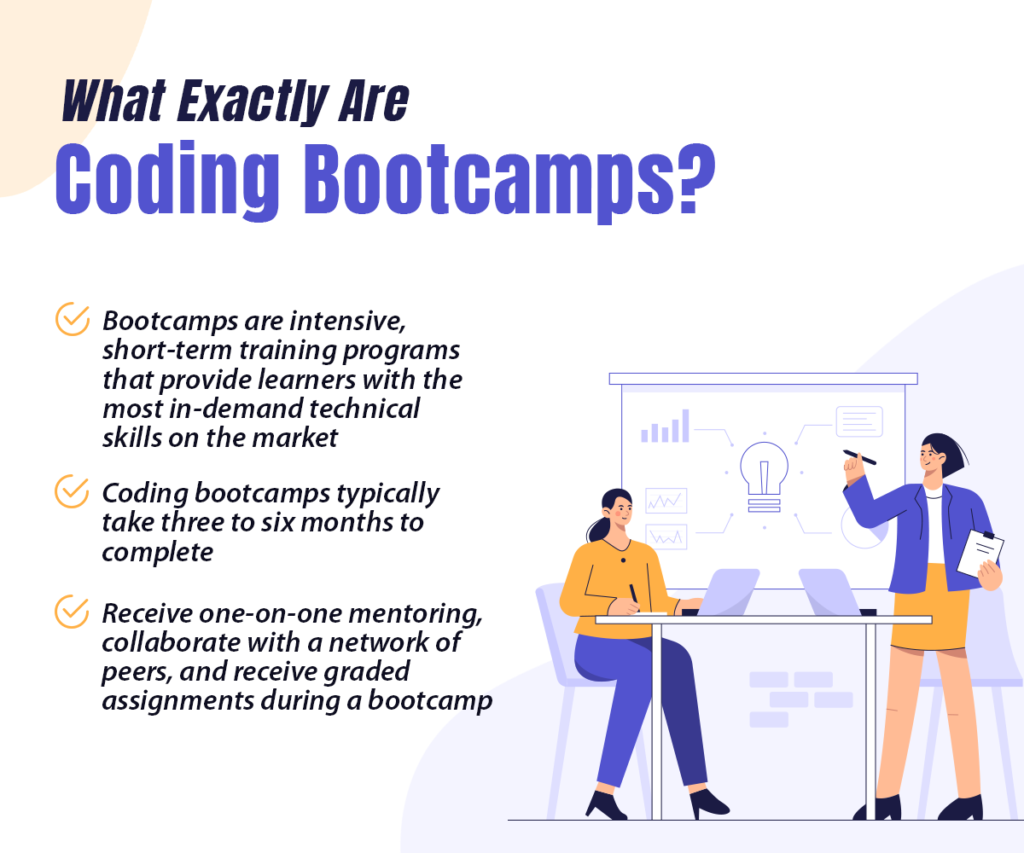Coding bootcamps and computer science degrees are two paths to high-paying tech jobs. According to Switchup research, the average percentage of coding bootcamp and four-year college alumni hired by the top five tech companies was 6.03% and 6.60%, respectively. Programming bootcamps may also teach Ruby on Rails, full stack JavaScript, .NET/C#, Java programming, Python, ReactJS or PHP.
Because of the lower total cost and shorter time to enter the workforce, many professionals choose to attend a bootcamp. Some employers, on the other hand, still prefer professionals with bachelor’s degrees.
This article provides a comprehensive list of factors to consider when deciding between these two options.
What Exactly Are Coding Bootcamps?
You may be wondering if coding bootcamps are worthwhile. Are coding bootcamps trustworthy?
Most undergraduate degrees, however, require four years of full-time study. It’s not a trivial commitment, especially if you have other professional or personal obligations to meet. Furthermore, college requires a financial investment that not every aspiring programmer can afford — and that’s okay. Coding bootcamps are available to fill the void
Before we get into the specifics, let’s go over the fundamentals. What exactly are coding bootcamps?

Bootcamps are intensive, short-term training programs that provide learners with the most in-demand technical skills on the market. Participants will be trained and ready to apply for entry-level developer jobs after completing the program. Learners can specialize in data science, digital marketing, UX/UI, cybersecurity, technical sales, or full stack development. The best bootcamp for you is ultimately determined by your personal preferences.
Coding bootcamps typically take three to six months to complete. Part-time courses typically allow students to balance their education with a full-time job. Full-time courses, like Java Full Courses on the other hand, present a demanding but effective schedule that upskills developers in just four months.
An aspiring developer can receive one-on-one mentoring, collaborate with a network of peers, and receive graded assignments during a bootcamp. Some bootcamps even provide learners with current industry problems that have been offloaded by partnering companies, allowing participants to supplement their resumes with real-world project experience.
After completing the course, most bootcamps offer in-office career networking services to participants. Reputable courses are interested in increasing their success rate and will do everything possible to connect successful students with advancement opportunities.
Last year, 10% of software engineers polled said they learned to code solely through bootcamps, and the percentage is even higher among younger populations. Almost one in every six Gen Z developers reported using bootcamps to learn new skills.
What Coding Bootcamps Will Teach You?
There are no two curricula when it comes to finding a bootcamp. Each bootcamp, like a traditional undergraduate degree program, has its own focus and coursework. Because there are so many new technologies and framework changes, course materials can frequently shift even within the same bootcamps.
Having said that, there are a few trends to keep in mind. First, with 44 percent of developers using JavaScript as their primary coding technology, it is currently the most popular teaching language for bootcamps which you can learn by enrolling in a Java full course.
Furthermore, according to Course Report’s 2019 research, 94% of coding bootcamp participants learn full stack web development.
However, bootcamps aren’t just for full stack developers. These courses are typically available in the following formats:
- Front End Development
Front end development is the practice of programming all of the features that end users (such as page visitors and app users) can see and interact with. Professionals in this field typically create web applications using HTML, CSS, and JavaScript.
Front end bootcamps typically teach modern frameworks such as React, Angular, or Vue in addition to the HTML, CSS, and JavaScript. Technical topics covered include jQuery, server-side management, DOM manipulation, TypeScript, and Bootstrap. Some students may also study the principles of good UX (user experience) design.
The curriculum will most likely concentrate on creating front end designs that support back end platforms, as well as converting web pages into mobile-optimized sites.
- Back End Development
The term “back end” refers to everything that the end user cannot see or interact with directly. The back end of an application typically includes the server, database, and behind-the-scenes business logic.
This all takes place without the client’s knowledge. The back end developer is in charge of ensuring that these unseen operations run smoothly, efficiently, and consistently. Because back end processes are the bottleneck for an application, these developers generally focus on optimizing a site’s speed and responsiveness. If the back end is slow, so will the site, and customers will leave.
They frequently provide a brief overview of server-side technologies such as Node.js, JavaScript, Express.js, and HTML. APIs (Application Programming Interfaces), which allow your project to communicate with the databases of other sites, may also be covered in class.
- Full Stack Development
Consider a full stack application to be a restaurant: the front end is where the client is served a meal, and the database is the pantry — it stores ingredients, changes them as needed, and uses its stores to create meals. The server is analogous to a kitchen, where various ingredients are only assembled upon the client’s request.
To broaden the metaphor, full stack would refer to the entire restaurant’s operations, from the back warehouses to the plated dishes on the tables. Full stack developers are capable of managing and developing entire websites and applications, but they typically specialize in one or two languages. They are the much-needed “jacks of all trades” in the software industry.
HTML, CSS, JavaScript, Node.js, MongoDB, dynamic HTML templating, RESTful routing, and APIs are common topics covered in full stack bootcamps. However, the specific “stack” of skills may vary greatly between bootcamps.
And a great option for you to learn full stack development with complete frontend and backend course from Geekster. This platform offers the highest quality education feasible to everyone!
What is traditional teaching?
Let’s start with a general description of a “traditional” teaching environment. To what boot camps are being compared?
In general, high schools and colleges operate in a similar manner. It’s the “sit and get” method of education: you gather a group of people in a room, one person speaks, you take notes/do exercises, and then you leave. Outside of class, you’re usually doing homework to reinforce what you’ve learned. One class doesn’t change much – Monday looks like Tuesday – the same patterns repeat themselves. Most people are accustomed to this model in high school and college.
Students take general education credits in English, math, science, business, and history, as well as computer science courses, over the course of a four-year bachelor’s degree in computer science. To demonstrate proficiency, some employers prefer professionals to have a broad general education and a degree.
College students have time to learn advanced concepts as well. Courses in data structures, programming languages, and software engineering are common in computer science curriculums, as well as electives.
Traditionally, these jobs have required a bachelor’s degree or higher. According to a Switchup study, computer science graduates and bootcamp alumni had comparable average employment at major tech companies. A bachelor’s degree in computer science provides a solid educational foundation, as well as coding abilities. Employers frequently prefer bachelor’s degree holders.
Return on investment (ROI) assesses the profitability of an investment. This approximation approximates the total financial return on an expense. Both coding bootcamps and a computer science degree are investments in your future earnings potential. Calculating ROI can assist you in making important decisions.
There are three steps involved in calculating ROI:
- Subtract the initial investment (cost) from the final value.
- Divide this figure by the investment cost.
- Increase the total by 100%. This is given as a percentage.
Degrees in computer science are highly valued. They can lead to increased pay throughout a professional’s career (higher possible lifetime ROI).
Having the Best of Both Worlds
Still undecided about which path to take? The good news is that you are not required to!
Within your lifetime, you can enroll in both a best coding bootcamp and a computer science degree program. Coding bootcamps and bachelor’s degrees offer complementary skill sets and networking opportunities that can help a professional advance in their career.
A recent college graduate who has been working in the tech industry for several years may want to improve their skills and enroll in a coding bootcamp. Alternatively, after gaining skills in a bootcamp, a bootcamp graduate may wish to enroll in college.
Earning a college degree can offset the disadvantages of bootcamps. Professionals can get credit for work experience or even earn a degree part-time while working in technology to complete a degree faster. Rather than deciding between a coding bootcamp and a computer science degree, many professionals opt for both.




